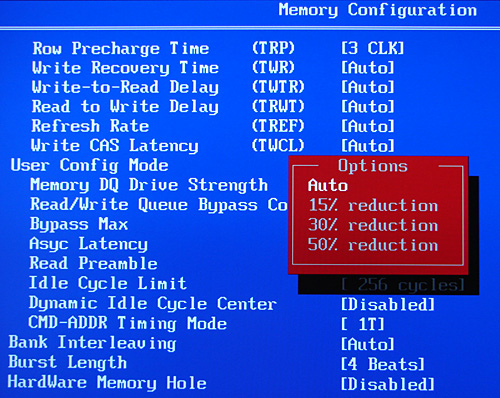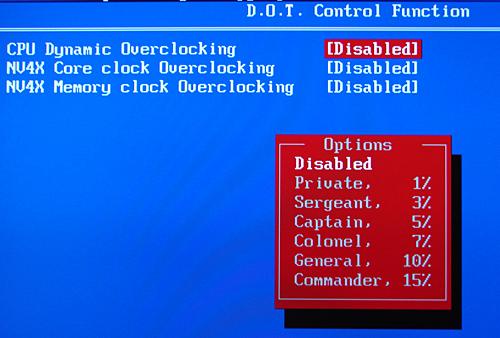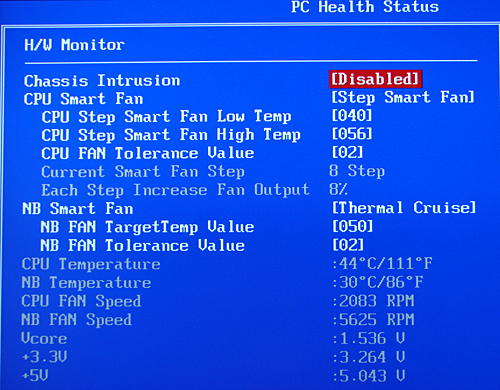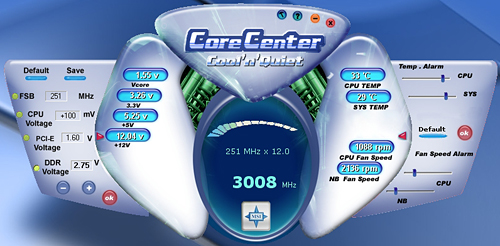Basic Features
The MSI K8N Diamond Plus is an upper-price ranged performance board targeted towards the AMD enthusiast user. The board ships with an extensive accessory package that includes rounded IDE cables, SATA cables, power connectors, SLI bridge card, Firewire backplate, and a 2 USB port/Diagnostic LED backplate. MSI also includes an extensive utility CD and documentation package.

Checking out the BIOS, the Cell Menu section is where most users will spend the majority of their time tweaking this board. While the selection of BIOS options is not as extensive as a DFI board, they are quite numerous and target the enthusiast user. The BIOS allows for CPU voltages up to 2.15V with the additional CPU voltage adjustment along with HTT bus speeds from 200 to 450 MHz. CPU ratios from 5x to 25x are also offered depending upon your CPU type, and the HTT multipliers for the NB and SB links can be independently set from 1X-5X.


The Memory Configuration section allows the user to control memory timing adjustments and dividers. The amount of manual settings available is impressive and without a thorough understanding of each setting, your board could be tuned incorrectly or left inoperable until the BIOS recovery system comes to the rescue. The BIOS allows for Auto settings that will determine the best timing attributes based upon memory type, divider, and bus speeds. We found in our testing the Auto setting would typically adjust the memory clock settings correctly if not a bit relaxed at times. Memory voltage settings are offered up to 3.20V and if you want to void the warranty on the board, MSI provides a switch block that will allow a voltage range from 3.35V to 4.10V.

The D.O.T. Control Function section allows the user to automatically set an overclocking level and then let the system worry about managing the various HTT, CPU, and RAM settings. The system provides for six different dynamic overclocking modes with percentages ranging from 1% to 15%. The BIOS also allows the same settings to be applied to certain NV40 based graphics cards. As a rule, all of these settings are disabled by default.

The PC Health Status section offers the ability to control fan speeds automatically. The BIOS allows the user to set temperature and fan speed targets for the Northbridge and CPU fans, though control and monitoring of the board's chassis fan headers absent. Unlike the BIOS settings from Abit, the MSI BIOS is lacking fan failure notification, automatic temperature-based shutdown settings, and low-RPM alarms.

MSI ships several applications with their board with the most interesting yet disappointing one being the Core Center application. Although advertised as an overclocking utility that one would find very useful, it can only adjust the Dynamic Overclocking settings along with certain voltage settings. The application in essence is a temperature and fan monitoring software utility with limited abilities to change BIOS level settings. However, unlike the BIOS, the user can set fan speed and temperature level alarm conditions for the CPU and Northbridge fans - assuming of course that you're willing to always have Core Center running in the background.
| MSI K8N Diamond Plus Specifications | |
| CPU Interface | 939-Pin Socket supporting AMD Athlon 64 / 64FX / 64X2 |
| Chipset | NVIDIA C51D - North Bridge NVIDIA nForce4 SLI - South Bridge |
| HTT Speeds | 200MHz ~ 450MHz in 0.5MHz increments up to 210HTT, 1MHz increments up to 450HTT |
| CPU Clock Multiplier | Auto, 5x ~ 25x in 1x increments (maximum multiplier dependent upon processor utilized) |
| Memory Speeds | Fixed Dividers - 1/1, 1/2, 2/3, 5/4, 5/6 |
| PCI Bus Speeds | Fixed at 33.33MHz |
| PCI Express Bus Speeds | 100.00MHz ~ 148.4375MHz, various increments |
| LDT Multipliers | Auto LDT to NB, 200MHz, 400MHZ, 600MHz, 800MHz, 1GHz - LDT to NB, NB to SB, SB to NB |
| LDT Link Speed | 8-bit, 16-bit |
| Core Voltage | Startup, 0.800V ~ 1.400V, in .025 increments, Vcore Adjustment +.05V ~ .75mV in .05V increments |
| DRAM Voltage | 2.65V ~ 3.20V, auxiliary switch for 3.35V~4.10V, .05V increments |
| Memory Slots | (4) x DIMM, max. 4GB, DDR 400/333/266, non-ECC, un- buffered memory, Dual Channel Operation supported. |
| Expansion Slots | (2) x PCI-E x16 (each slot operates in 1x16 mode in SLI) (2) x PCI-E x1 (1) x PCI-E x4 (2) x PCI 2.3 |
| Onboard SATA | NVIDIA nForce4: (4) x SATA 3Gb/s Silicon Image - SiL3132: (2) x SATA 3Gb/s (NCQ, Hot Plug) |
| Onboard IDE | NVIDIA nForce4: (2) x UltraDMA 133/100/66/33 |
| SATA/IDE RAID | NVIDIA nForce4: (4) x SATA 3Gb/s - RAID 0, RAID 1, RAID 0+1, RAID 5 SiL3112: (2) x SATA 3Gb/s - RAID 0, RAID 1 |
| Onboard USB2.0 | (10) USB2.0 ports (four I/O panel ports, three board headers for six more ports) |
| Onboard LAN | Marvell 88E1115 PCI Gigabit Ethernet PHY Marvell 88E8053 PCI-E Gigabit LAN Controller |
| Onboard Audio | Sound Blaster Audigy SE, 8-channel HD audio |
| Onboard Firewire | VIA VT6306 IEEE 1394 chipset - 1394A capable |
| Power Connectors | 24-pin ATX 8-pin ATX 12V 4-pin 12V (required for SLI or dual card operation) |
| Back Panel I/O Ports | 1 x PS/2 Keyboard 1 x PS/2 Mouse 1 x Audio I/O Panel 2 x RJ45 LAN 4 x USB 2.0 1 x Serial Port 1 x Parallel Port 1 x IEEE 1394 Port 1 x S/PDIF Coaxial Out 1x S/PDIF Optical Out - TOS Link |
| Other Features | DigiCell- Inclusive Monitoring / Configuration Program Live Update - Windows based driver/bios update utility Core Center - Windows based Monitoring / Overclocking Utility Mega Stick - MSI MP3 Program I-Speeder - Network Monitoring Utility CoreCell- Dynamic Overclocking |
| BIOS | AMI 3.0a (3/21/06) |
The MSI K8N Diamond Plus is an upper-price ranged performance board targeted towards the AMD enthusiast user. The board ships with an extensive accessory package that includes rounded IDE cables, SATA cables, power connectors, SLI bridge card, Firewire backplate, and a 2 USB port/Diagnostic LED backplate. MSI also includes an extensive utility CD and documentation package.

Checking out the BIOS, the Cell Menu section is where most users will spend the majority of their time tweaking this board. While the selection of BIOS options is not as extensive as a DFI board, they are quite numerous and target the enthusiast user. The BIOS allows for CPU voltages up to 2.15V with the additional CPU voltage adjustment along with HTT bus speeds from 200 to 450 MHz. CPU ratios from 5x to 25x are also offered depending upon your CPU type, and the HTT multipliers for the NB and SB links can be independently set from 1X-5X.


The Memory Configuration section allows the user to control memory timing adjustments and dividers. The amount of manual settings available is impressive and without a thorough understanding of each setting, your board could be tuned incorrectly or left inoperable until the BIOS recovery system comes to the rescue. The BIOS allows for Auto settings that will determine the best timing attributes based upon memory type, divider, and bus speeds. We found in our testing the Auto setting would typically adjust the memory clock settings correctly if not a bit relaxed at times. Memory voltage settings are offered up to 3.20V and if you want to void the warranty on the board, MSI provides a switch block that will allow a voltage range from 3.35V to 4.10V.

The D.O.T. Control Function section allows the user to automatically set an overclocking level and then let the system worry about managing the various HTT, CPU, and RAM settings. The system provides for six different dynamic overclocking modes with percentages ranging from 1% to 15%. The BIOS also allows the same settings to be applied to certain NV40 based graphics cards. As a rule, all of these settings are disabled by default.

The PC Health Status section offers the ability to control fan speeds automatically. The BIOS allows the user to set temperature and fan speed targets for the Northbridge and CPU fans, though control and monitoring of the board's chassis fan headers absent. Unlike the BIOS settings from Abit, the MSI BIOS is lacking fan failure notification, automatic temperature-based shutdown settings, and low-RPM alarms.

MSI ships several applications with their board with the most interesting yet disappointing one being the Core Center application. Although advertised as an overclocking utility that one would find very useful, it can only adjust the Dynamic Overclocking settings along with certain voltage settings. The application in essence is a temperature and fan monitoring software utility with limited abilities to change BIOS level settings. However, unlike the BIOS, the user can set fan speed and temperature level alarm conditions for the CPU and Northbridge fans - assuming of course that you're willing to always have Core Center running in the background.










42 Comments
View All Comments
DigitalFreak - Tuesday, April 11, 2006 - link
Agreed. However, there are alternatives if you have the PCI-E slots available. Going the add-in route also allows you to run off the PCI-E bus. 1394b can saturate the PCI bus.http://www.siig.com/product.asp?pid=1013">PCI-E Firewire 800 adapter
Olaf van der Spek - Tuesday, April 11, 2006 - link
[quote]MSI provides an SLI Video Link card that is long enough to connect two NVIDIA based video cards for SLI operation along with a digital switching method that eliminates the use of jumpers to configure SLI capability.[/quote]Does that switch between dual x16 and dual x16???
DigitalFreak - Tuesday, April 11, 2006 - link
LOL Sounds like someone has been cut & pasting together reviews.Gary Key - Tuesday, April 11, 2006 - link
No cut and paste, the sentence content was corrected, lets call it an editorial difference of opinion. :)decalpha - Tuesday, April 11, 2006 - link
http://anandtech.com/mb/showdoc.aspx?i=2739&p=...">http://anandtech.com/mb/showdoc.aspx?i=2739&p=...The MSI K8N Diamond Plus was extremely stable with 4 DDR2 modules in Dual-Channel operation
Wesley Fink - Tuesday, April 11, 2006 - link
Corrected to DDR.MIKEMIKE - Tuesday, April 11, 2006 - link
meant that to read:Something about the first page irked me, it isnt a normal introduction to the item being reviewed. it seems as if that needs to be a second page, and a new first page drafted up.
redbone75 - Tuesday, April 11, 2006 - link
I may be mistaken, but I think it's called an introduction.MIKEMIKE - Tuesday, April 11, 2006 - link
Something withthe layout, and introduction of the mobo irked me and turned me off of the review in general, not sure what specifically though.Gary Key - Tuesday, April 11, 2006 - link
Thanks for the comments. At times we try different layouts, some work, some do not, but hopefully we progress for the better over time.